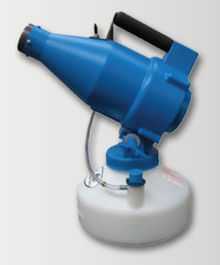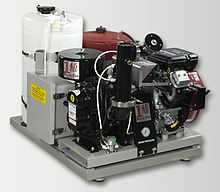Ultra-low volume
The term Ultra-Low Volume (ULV) (spraying) is used in the context of pesticide application.
Ultra-low volume application of pesticides has been defined as spraying at a Volume Application Rate (VAR) of less than 5 L/ha for field crops or less than 50 L/ha for tree/bush crops.[1] VARs of 0.25 – 2 l/ha are typical for aerial ULV application to forest or migratory pests.
ULV spraying is a well-established spraying technique[2] and remains the standard method of locust control with pesticides and is also widely used by cotton farmers in central-southern and western Africa. It has also been used in massive aerial spraying campaigns against disease vectors such as the tse-tse fly.
A major benefit of ULV application is high work rate (i.e. hectares can be treated in one day). It is a good option if all (or some) of these conditions apply:
- large area of land to treat
- rapid response required
- little or no water for making pesticide tank mixtures
- logistical problems for supplies
- difficult terrain: poor access to target site
Equipment
ULV equipment is designed to produce very small droplets, thus ensuring even coverage with low volumes. The equipment is based on aerosol, air-shear (mistblowers, exhaust gas sprayers) or better still, rotary nozzle techniques.[3] An electrostatic charge may be applied to the droplets to aid their distribution and impaction (on earthed targets), but commercial equipment is rare at present.
Ultra Low Volume Fogging Machines
Ultra low volume (ULV) fogging machines are cold fogging machines that use large volumes of air at low pressures to transform liquid into droplets that are dispersed into the atmosphere. This type of fogging machine can produce extremely small droplets with diameters ranging from 1-150 µm. ULV machines are used for applying pesticides, herbicides, fungicides, sterilizers, and disinfectants amongst other chemicals. The size of the droplet is very important as each application has an optimal droplet size. The optimum droplet sizes are between 5 and 20 µm for flying insects, 20 to 40 µm for leaf nematodes and 30 to 50 µm for fungi.[4] Low volume refers to the low volume of carrier fluid that is required with these types of machines. The droplets that are created are of such a small size that less carrier for the formulation is required to cover the required surface area. The best way to understand the concept of using less formulation to cover a larger surface area is to look at the mathematical side of the scenario.[5] In the case where the diameter of a droplet is reduced to half its original size then the amount of droplets that can be formed from the same volume of formulation will increase eight fold. If the droplet diameter is reduced to 10 percent of its original size, then the amount of droplets that can be formed will increase a thousand fold. In this way the droplet diameter determines the amount of droplets that will form.[5]
ULV Fogging Machine Parts

The nozzle of the machine has a very specific shape, which causes a swirling motion of the air stream. The motion is achieved by means of several stationary fins that force the air to rotate. The formulation is delivered to the air by means of a supply tube that is situated in the center of the nozzle. The motion of the air shears the liquid formulation into very small droplets and then disperses it into the atmosphere.[6]

ULV Fogging Machine Advantages and Disadvantages
The chemicals dispersed in this type of machine are more concentrated than the chemicals used in other spraying equipment, which also increases the killing efficiency. Other advantages of ULV misting machines includes lower risks of injury due to the fog cloud being nearly invisible, low volumes of carrier chemicals, lower application cost and low noise levels.[8] Unfavorable aspects of these machines may include longer application times, wind drift, high concentrations of active ingredients causing environmental hazards, and the requirement of higher technical skills for calibration of the machines.[8]
ULV Fogging Machine Applications
ULV fogging machines can be used in a number of different industries. Some applications includes mosquito control, bird control, agricultural applications such as grain storage, disinfectant purposes such as hospitals and laboratories, mold control and surface decontamination.[6] A specific application for ULV machines that have been well researched is protecting avocado trees from different diseases. The most common diseases that these trees are prone to suffer from includes Cercospora spot, anthracnose and stem-end rot.[9] The diseases affecting the avocado trees are controlled by applying high volume copper oxychloride fungicides to the trees. The original application techniques included the use of a hand gun sprayer. This technique posed the problem of high run-off of the formulation. The use of ULV machines for the application of the pesticide formulation yielded more than 80 percent healthy fruit that was free from Cercospora spot. These results compared very favorably with the traditional method of using a hand gun sprayer.[9] Another industry that have benefitted substantially from the technology provided by ULV fogging machines is the chicken industry. This industry suffers great losses due to the litter beetle and a fungus called Asprigillus. ULV fogging machines offers great solutions to kill both these pests in chicken houses.[6]
See also
References
- ↑ Matthews, G.A. (2000) Pesticide Application Methods 3rd Edition. Blackwell Science, Oxford. 432 pages.
- ↑ Maas, W. (1971) ULV Application and Formulation Techniques. NV Philips Gloeilampenfabrieken, Eindhoven, NL. 165 pages.
- ↑ "Sprayers and other Application Equipment". Dropdata.org. Retrieved 2009-04-10.
- ↑ Meyer, Thomas (2013), Cold Fogging for the Future, Greenhouse Product News, retrieved 10 March 2013
- ↑ 5.0 5.1 Becker, Kurt (June 2008). "Fogging for Effective Pest Management". GPN Magazine (GPN Magazine): 44–45. Retrieved 18/03/2013.
- ↑ 6.0 6.1 6.2 6.3 Curtis Dyna-fog ltd. (2012), Spray Classification and Droplet Characteristics, Curtis Dyna-fog ltd, pp. 17–20, retrieved 18/03/2013
- ↑ Dyna-fog Africa (2013), About Fogging, p. Dyna-fog Africa, retrieved 10 May 2013
- ↑ 8.0 8.1 Armed Force Pest Management Board (2011), Technical Guide Number 13: Dispersal of Ultra Low Volume Insecticides by Cold Aerosol and Thermal Fog Ground Application Equipment, Washington: Armed Forces Pest Management Board, retrieved 10/03/2013
- ↑ 9.0 9.1 van Niekerk, J.M.; Z.S. Mavuso (2012). "Evaluation of ultra-low volume funcicide applications for the control of diseases on avocado fruit". South African Avocado Growers’ Association Yearbook (Tzaneen: Westfalia Technological Services) (30): 63–68. Retrieved 18/03/2013.